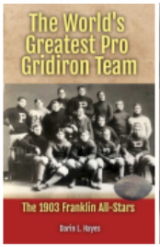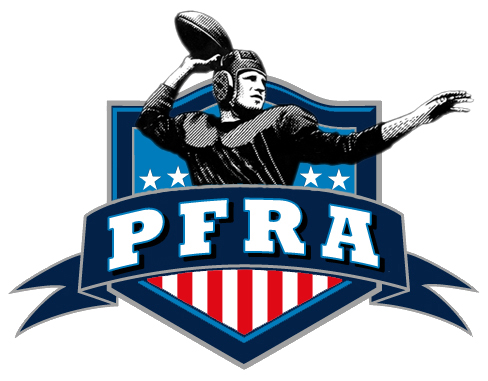The Draw Play in football is still used as an element of surprise at all levels of football. It is also quite a common play choice when a team is in the unen... — www.youtube.com
The draw play – a staple of football offenses, a play that keeps defenses guessing. But where did it come from? Who first thought of faking a pass and then handing the ball off? Today, we're joined by renowned football historian Timothy Brown to crack open the dusty playbook and uncover the surprising origins of the draw play.
The story originates from a recent Tidbit of Tim's titled:
The Origins of the Draw Play.
The Draw Play in football is still used as an element of surprise at all levels of football. It is also quite a common play choice when a team is in the unenviable position of third and really long as a way to garner some cheap, safe, and easy field position to set up the punting unit,
Timothy Brown joins us to talk about the origins and the purpose of the draw play in this episode.
-
Transcript of the Origins of the Draw Play with Timothy Brown
Darin Hayes
Hello My Football friends. This is Darin. Hayes of pigskindispatch.com. Welcome once again to the pig pen your portal to positive football history and welcome to another Tuesday where we get to visit with our friend Timothy Brown of
football archaeology dot com. Tim, welcome back to the pig pen.
Timothy Brown
Hey, Darin, I am looking forward to chatting, and hopefully, this discussion will not get too drawn out, if you know what I mean.
Darin Hayes
Oh, you are just the master of the Segway, and folks, these are not pre-rehearsed, So these are just as much a surprise to me as they are to you when they come out, but
Timothy Brown
They got it. Dad jokes are what make the world around.
Darin Hayes
Yeah, we are both dads and grandfathers, and we have the jokes coming at us. So, you know, so pardon our humor. But Tim is segueing into a title that his tidbit he's going to talk about tonight, which he had titled The Origins of the Draw Play, which is a very famous play. And when it's still common today in football. So, Tim, what do you get to tell us about the origins of the draw play?
Timothy Brown
Yeah, so well, I think part of what's fun about the draw play, like a lot of things in football, is kind of, you know, people always talk about, you know, the game, you know, football repeats itself that, you know, that there's this whole thing about, you know, well, we've seen and done that before. And, you know, in a lot of cases, that has been the case, but it always kind of comes back to, well, what do you mean, you know, so what is it about like today's draw play that you can see and spot in earlier versions of that play. And so that's kind of what this tidbit was about. And so, so, you know, like a lot of things, you know, I recently did a tidbit on homecoming. And the first homecoming, so in order to talk about that, you have to define, OK, well, what a homecoming is and what the elements of a homecoming are. So with the draw play, it's like, well, what's a draw play? And, you know, for me, it comes down to the draw play is a play in which it is a, it's a fake pass with a, with a, with a run that is, you know, a predetermined run. So it's not, you know, back in the day they used to, out of the, you know, single wing, double wing, and probably, you know, out of the Notre Dame, you know, and Minnesota boxes and all those kinds of things. You know they, they'd send a back out wide on a run-pass option, not the RPO we know today, but a run-pass option, where it was like, OK, you either run the ball, but if the guys open, throw at home. So that's an option that was still an option play whereas, you know, draw it's predetermined you call it, call it in the huddle, you're going to fake a pass, and then run it, you know, and it's an attempt to kind of take advantage of the pass rushers coming at you.
Darin Hayes
And what you're saying is that you're basically having your lineman pass block instead of the traditional run block where they're trying to go beyond the line of scrimmage. They're trying to stay on their side of the line of scrimmage and just protect but open a hole.
Timothy Brown
Yeah, I mean, back in the day, there wasn't that restriction on the linemen, you know, they could go downfield. Right. So I mean, some of that stuff gets a little bit mixed up. And even, you know, as far as I can tell, there wasn't a heck of a lot of difference between past blocking and around blocking back in the day. But you know, now in today's world, yes, 100%, right. But that's, you know, that's our, you know, 21st-century mind, defining, you know, what a draw play is. But back then, so the first, you know, I wrote this about Fritz Chrysler when he was coaching at Michigan. And he had drawn up a play for, you know, postseason or preseason guide that Grant let Rice was doing. And he basically had his single-wing tailback get the deep snap. And then he rolled out as it's drawn up anyways, he rolled out left, you know, kind of stood there for a second. And he had like, you know, the whole backside of the line, and the backs were out there starting to block for him. But a couple of them leaked out into the, you know, downfield. And then, you know, I mean, everything appeared that he was going to pass it, and then boom, he takes off. Right. So now that, you know, in my definition, it would be a draw play. Right. I mean, it's not what we think of today as a draw play because this is 1939. And then modern tee with a quarterback under center and then dropping, you know, kind of straight back, you know, backpedaling or, you know, turning and kind of carioca, but, you know, peddling back that first showed up in 1940, you know, a year later. So anyways, you know, it's one of those things where there's a lot of football references that say that that the draw play that we now think of, you know, tee quarterback, you know, backing out and then giving it to a fullback or a halfback. A lot of people say that that was, you know, one of the Chicago Bears plays. But it's not in the 1946 Chicago Bears playbook that, you know, Hallis and Shaughnessy and those guys wrote. So, you know, so then I'm going, OK, well, I don't believe it then. Right. Because they've got 80 plays there. So the first place that I saw the term draw play in newspapers anyway came in the 1950 Rose, not Rose Bowl, but Cotton Bowl. And so that was a game with, you know, two games or two teams you wouldn't expect to be in the Cotton Bowl today necessarily. But TCU, which, OK, you can believe TCU is in the Cotton Bowl, then Carnegie Tech. So, it's not a team that is going to show up in the cotton today. But you know, TCU had three top 10 NFL, you know, first-round picks the next year. One of them was an All-American quarterback, Davey O 'Brien, you know, who was a stud. I'm sorry, I'm messing that up. They had Tobin Roat, and Rice beat UNC. I'm mixing up which story I'm talking about. So Tobin Roat was a quarterback, and he, you know, operated out of the dropback tee. And then, you know, the other thing. So it was a low-scoring game, and he ends up, you know, basically, they won the game as a result of, you know, running a draw play, you know, and a draw play the way that we think of it today. But still, at the time, they didn't call it a draw play, or at least if they called it a draw play on the field or in practice, that didn't get communicated out to the wider world. Because the first time I found the term draw play in the newspapers, you know, came a few years later. And so it was a guy by the name was Dick Cullen, who was a Minneapolis sports writer. And he must have been a guy who was, well, I know for sure he was because I've read enough of the stuff. He was one of these sports writers who kind of got into the play, and the terminology is more of a technical sort of guy, you know, so if you think now about the like the color analysts that are on TV or radio, he was like, maybe a little bit more of a football expert who could provide that kind of, you know, input into the game. And because he's, you know, so draw play, you know, that shows up in his writing, you know, not too long, you know, after the Cotton Bowl. And then he's also, ironically, the first guy to use the term dropback quarterback, which isn't, you know, T formation play or T formation term, but that didn't show up until 1964. So it was, yep. You know, so the T was there in 1940, the modern T. And it's 24 years later before it shows up in print. Wow. And then, two years later, he's the first guy to use the term skill positions. So, you know, it's just one of those things. It's kind of cool that, you know, I started noticing, like, you know, when I wrote, I wrote a book called Hut Hut Hike about the origins of football terminology, and so he kept showing up, and it's like, OK, well, this guy, you know, I mean, he obviously is one of those guys who kind of liked that side of the game and wanted to educate his, his, uh, his audience, you know, his readers on what was happening and what was different about the game today than it had been the previous year.
Darin Hayes
OK. Well, I'm glad you mentioned Hutt Hutt Hike. Cause I was going to go right into that a little bit. With your Hutt Hutt Hike, uh, storytelling and your research on there, where, what does the draw play, where, where does the draw come from? Is it from drawing the defenders in to fool them?
Timothy Brown
You know, sometimes it's hard to tell that's my assumption. OK, it's that you're drawing, you know, you're drawing them into your trap.
Darin Hayes
OK.
Timothy Brown
Yeah. And that's even another like a trap, you know, that comes from originally that was it was called a mousetrap. You know, that you were the trap lady on somebody and then and, you know, hitting them from the side. But it was it was called a mousetrap, not a trap. And then they just shortened it because it took too long to see the mousetrap.
Darin Hayes
Oh, thank, thank God that our football forefathers were simple people like us and the naming, you know, you can like to dropback quarterback. OK. We can figure out where that came from. Uh, but yeah, but some of those things, like the trap play and the draw play, were our explanation. So, thank you for that. So.
Timothy Brown
Now, so sometimes, it's just fun. For example, dropback quarterback is one of those where you'd think, well, what did they call it in those 24 years? Like if you were teaching somebody, here's what I want you to do. I want you to backpedal. And a lot of times, they were just, you know, straight backpedaling back then. You know, so how did coaches describe it? Yeah, you know, I don't have. I've only got a handful of playbooks from the old days. Most of all, I'm dealing with newspaper articles to try to figure it out.
Darin Hayes
But think about that the first time a player's told to do that. You know, football is a game of moving forward. You know, when you're on offense, you're, you're, you're trying to go forward. And now you're, you have a coach telling you to retreat a little bit, to give up ground, uh, to make something happen. So that had to be kind of a wide, wide, eyes wide open type of situation.
Timothy Brown
Yeah, well, you mentioned the pass blocking. So, you know, the whole, you know, cup blocking, you know, that was, you know, you had to teach somebody to give ground, you know, and before that, what they used to do a lot of times is, you know, the center and tackles would meet the, you know, meet their guys, you know, straight up, and the guards would if they were covered, but if they weren't covered, you know, then they'd loop back and pick up the ends, you know, coming off the edges. And yeah, you can see the plate drawings from back then. And I mean, it's very clear what they're doing. But you just don't see that anymore. You know, that's just not, you know, the cup was a really interesting innovation because it was basically zone blocking, only you're doing it passively, you know, so it was really a, you know, kind of a revolutionary way to think about, you know, blocking.
Darin Hayes
Until the defense of coordinators was countered with stunts and all kinds of craziness.
Timothy Brown
But actually, it was because of the stunts that they started doing it, you know, because they were stunting and like what we now call blitzing, they called Red Dog back then, you know, they'd send somebody, you know. And, you know, for so long, it was just, you know, seven guys on the line of scrimmage, and they just come at you. So you had the man who was over you. But then once they started dropping backers, then they start, you know, they start doing twists, and they start, you know, there are all kinds of things that happened, but really, pass blocking is zone blocking, you know, but you're doing it passively. Whereas, you know, zone blocking on the run, you know, you're picking up an area, it's area blocking, you know, you're, and then there's more to it than that. But nevertheless, I mean, so it's really, I don't know, it's just one of those things that it's just this kind of a revolutionary way of thinking about it. And so sometimes, sometimes it's like it happens right away. Somebody devises a new scheme, and other times, they, you know, football, just took baby steps to get there, but it's fun. You know, to me, that's the fun thing: the whole evolution of the game and how it got from here to there.
Darin Hayes
And, as you said at the very beginning, it's sort of a cyclical thing. So you've seen, you know, in the last ten years, uh, elements of the single wing coming back with, uh, you know, what they're, you're calling the, um, uh, what are the pros calling it out the wildcat offenses that are coming out, which is really single wing concepts to it.
Timothy Brown
You know, I've seen a number of plays in the US field games. You know, they're running, and they're running the modern T, a straight T in the backfield. So it's just a change-up its way to, you know, challenge the, you know,
Darin Hayes
You sit there and think about some of these younger defensive coordinators and players. You know, they've never seen anything like the single wing. So it's a whole new offense to them and they got to figure out how to defend it. So I'm sure there are coaches going back through some old books and film and trying to figure out, hey, how'd they do this in the 1940s?
Timothy Brown
Yeah. And part of it is just, you know, so the game has gotten to be so much of a speed, speed game, spread them out the game, that, you know, you want to come at me with, you know, 11 men in the box, then that changes, you know, the kind of people I need on the defense, right? So, you know, I mean, it's just total, you know,
Darin Hayes
That even I'll skip them.
Timothy Brown
It's a lot of fun stuff.
Darin Hayes
Yeah, definitely. Well, Tim, since we talked about it a couple of times, so what do we give the opportunity to help people get their hands on a copy of Hike? Because it's really an interesting book.
Timothy Brown
Yeah, thank you. So, you know, it's out on Amazon. You know, my three books will be on Amazon soon. My fourth one will be on Amazon, but Yeah, so just you know, look for me, look at my name or look up Hut Hut Hike or how football became a football, and You know, If you can find my name, then all three of them are gonna be available, and worst case go to go to
football archaeology calm, and you know that I've got you to know, the books list in different places on the site.
Darin Hayes
OK, excellent. Well, Tim, we really appreciate you bringing back this concept of the draw play, explaining it to us a little bit, telling us some of the history and the origins of it. And we'd love to talk to you again next week about another early football concept.
Timothy Brown
Very good. I look forward to it. Thanks.










